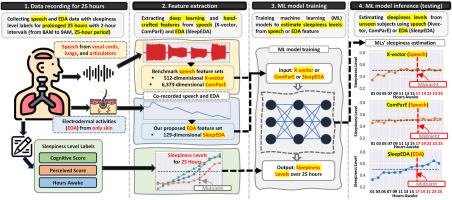实现真实世界的可穿戴睡意检测:说话时的皮电活动数据可识别睡眠不足情况
IF 7
2区 医学
Q1 BIOLOGY
引用次数: 0
摘要
准确评估嗜睡程度对于管理睡眠不足导致的疲劳风险至关重要。语音信号很容易获得,可以在任何地方检测嗜睡程度。以往使用语音进行的机器学习(ML)研究未能成功实现对感知嗜睡程度的可靠估计,从而导致嗜睡判断不准确。在本文中,我们提出这些挑战主要源于语音信号固有的复杂性和不准确的困倦标签。由于嗜睡对身体的影响在长时间清醒后会变得非常明显,因此我们进行了一项为期 25 小时的睡眠剥夺研究。我们收集了 30 名受试者在 25 小时内每 2 小时说话时的皮电活动(EDA)和语音数据,以及不同的嗜睡程度标签--他们从精神运动警觉性测试中得出的认知障碍分数、自我报告的嗜睡分数和清醒时间分数。数据分析比较了说话时记录的 EDA 和仅记录说话数据的 EDA,并研究了哪种方法能更好地使用 ML 估算和检测嗜睡程度。ML 结果表明,仅从语音生成过程中的 EDA 得出的特征能提供最准确的困倦判断。具体来说,与从语音中提取的 ML 特征(嗜睡程度估计相关性为 0.40,嗜睡检测准确性为 0.69(灵敏度为 0.59))相比,使用清醒时数分数训练的 EDA ML 模型提供了最佳的嗜睡程度估计(相关性为 0.53)和更好的嗜睡检测(嗜睡与认知性能下降有关)(准确性为 0.85(灵敏度为 0.80))。此外,与视觉警觉等其他活动中收集的 EDA 数据(准确度为 0.68,灵敏度为 0.65)相比,在语音生成过程中收集的 EDA 数据在嗜睡检测方面表现最佳。鉴于语音生成过程中 EDA 数据的潜力,这项研究表明,未来的可穿戴设备有望从语音活动中收集 EDA 数据和语音信号,从而实现更先进、更准确的真实世界睡意检测。本文章由计算机程序翻译,如有差异,请以英文原文为准。

Towards real-world wearable sleepiness detection: Electrodermal activity data during speech can identify sleep deprivation
Accurate assessment of sleepiness is pivotal in managing the fatigue-associated risks stemming from sleep deprivation. Speech signals are easy to obtain, allowing detection of sleepiness anywhere. Previous machine learning (ML) studies using speech have not been successful in achieving reliable estimation of perceived sleepiness levels, which results in inaccurate sleepiness determination. In this paper, we propose that these challenges primarily stem from the inherent complexities of speech signals with inaccurate labels of sleepiness. Because the physical effects of sleepiness become pronounced after prolonged wakefulness, we conducted a 25-h sleep deprivation study. We collected electrodermal activity (EDA) and speech data from 30 subjects during speech production every 2 h over the 25-hour period, along with various sleepiness level labels—their cognitive impairment scores derived from the psychomotor vigilance test, their self-reported sleepiness scores, and the h awake scores. The data analysis compared EDA recorded during speech versus only the speech data and examined which approach provided better sleepiness level estimation and detection using ML. The ML result is that features derived from only EDA during speech production provided the most accurate sleepiness determination. Specifically, EDA ML models trained using the hours awake scores provided the best sleepiness level estimation, with 0.53 correlation, and better detection of sleepiness (which is related to cognitive performance deterioration), with 0.85 accuracy (0.80 sensitivity), when compared to ML features derived from speech, which obtained 0.40 correlation for sleepiness level estimation and 0.69 accuracy (0.59 sensitivity) for sleepiness detection. Moreover, the EDA data collected during speech production offered the best performance for sleepiness detection compared to EDA collected during other activities, such as visual vigilance (0.68 accuracy and 0.65 sensitivity). Given the potential of EDA data during speech production, this work demonstrates the promise of future wearable devices that could collect EDA data from speech activity, along with speech signals, for more advanced and accurate real-world sleepiness detection.
求助全文
通过发布文献求助,成功后即可免费获取论文全文。
去求助
来源期刊

Computers in biology and medicine
工程技术-工程:生物医学
CiteScore
11.70
自引率
10.40%
发文量
1086
审稿时长
74 days
期刊介绍:
Computers in Biology and Medicine is an international forum for sharing groundbreaking advancements in the use of computers in bioscience and medicine. This journal serves as a medium for communicating essential research, instruction, ideas, and information regarding the rapidly evolving field of computer applications in these domains. By encouraging the exchange of knowledge, we aim to facilitate progress and innovation in the utilization of computers in biology and medicine.
 求助内容:
求助内容: 应助结果提醒方式:
应助结果提醒方式:


